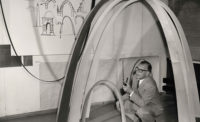When Iranian architect Milad Zabeti moved to the United States in January 2014, he was well on his way to achieving the American Dream. By 29, he had earned a master’s degree in architectural engineering from Worcester Polytechnic Institute, held degrees from two other international universities, and was hired by the firm Cambridge Seven Associates. Zabeti was also looking forward to the day when his wife Tannaz, an Iranian architect pursuing a Ph.D. in Italy, could join him in Massachusetts.
President Donald Trump’s executive order Friday—a decree that temporarily bans citizens from seven Muslim-majority countries, including Iran—has left Zabeti, his wife, and thousands of would-be immigrants at a loss. “You invest something,” says Zabeti about his decision to move to the U.S., “your life, energy, and ideas—everything. And then one sudden decision changes things.”
The shockwaves are resonating throughout the architectural community as designers, like Zabeti, and students struggle to make sense of their visa status and their options.
Architecture schools felt the effects immediately. According to the website FiveThirtyEight, 17,354 visas were issued for university students from Iran, Iraq, Syria, Libya, Somalia, Sudan, and Yemen in the 2015-16 academic year—many for architecture.
“None of us know exactly what the implications [of the ban] are,” says Nader Tehrani, the dean of Cooper Union’s Irwin S. Chanin School of Architecture—and an Iranian-American. “We are working to better understand them.”
To many, the scope of the order is nebulous. Tuesday morning, Toronto-based architect Nima Javidi, an assistant professor at Cooper Union, told RECORD he was detained at Newark Liberty International Airport for two hours, in spite of his Canadian citizenship. “To be fair, [the airport officials] were unclear of proper procedure,” says Javidi, who was born in Iran. “But it’s also worth noting that they were told that whoever you see born in those countries, take them in and keep them for a while.”
Fortunately, according to Tehrani, no one from his school has been denied entry to the U.S., but the new rule will prevent students from going abroad—to visit their homes or to participate in travelling architecture studios. “They’re in limbo,” he says.
Some students at Columbia’s Graduate School of Architecture, Planning, and Preservation (GSAPP) are facing a similar impasse. Though no architecture students were caught outside of the country at the time of Trump’s order, the ban, says Dean Amale Andraos, is “against all the values we stand for as a university committed to welcoming students and faculty, and to the free exchange of ideas and people.” She adds, “It’s quite devastating.”
The Los Angeles-based architecture school SCI-Arc, meanwhile, wrote in a statement to its students and faculty, “What affects one of us in our community affects all of us… SCI-Arc is committed to protecting the rights to all the members of our community, and to do whatever is possible within the law to keep doing so.”
Architecture firms are also speaking out. Daniel Libeskind, who grew up in Poland but moved to the United States in 1959 from Israel, argued that his studio wouldn’t exist without immigration. “The Trump travel ban is an affront to our freedom and core values. It affects our employees, colleagues and collaborators,” Libeskind’s firm said in a statement yesterday. “We are actively boycotting companies that support the current administration’s policies."
For many U.S. architecture offices, it is too soon to determine what the new restrictions will mean. Studio Gang, KPF, and Richard Meier & Partners told RECORD that they are still assessing the situation internally. “The new immigration ban is not yet affecting our firm,” a representative from Richard Meier wrote in an email, “but it is definitively something we are going to continue monitoring.”
The future remains equally uncertain for Milad Zabeti. He can join his wife in Italy and leave life in the U.S. behind, or wait to see what the next weeks bring. But for now, he is choosing to remain optimistic: “I hope that this is going to be something temporary and that we get back to the real America.”
Students at Cooper-Union also installed messages in the windows of academic buildings in protest.


